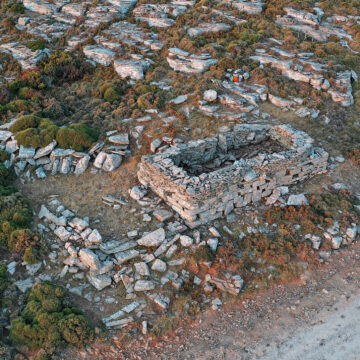The “dragon houses” of Euboea
Cyclopean buildings in southern Euboea
Some enigmatic dry stone buildings lost in the southern hills of Euboea stand out for the monumental size of their blocks. Eight of them are known located on the slopes of the mountain ridge around the village of Styra. The inhabitants of the region once said that they were built by dragons, anthropomorphic giants with supernatural strength. This explains their name drakospita or “houses of the dragons”, by which they are still referred to today. The cyclopean construction of these buildings and their corbelled roof system have long aroused the curiosity of archaeologists, but they are still far from having revealed all their secrets. In the absence of ancient parallels, the issues related to their dating and function(s) remains highly debated.
Exploratory trenches and survey
Archaeologists from the Swiss School of Archaeology in Greece (ESAG) and the Ephorate of Antiquities of Euboea (EAE) have been working since 2020 to shed light on these enigmatic constructions. This project aims to review previous research and to collect new archaeological evidence. Between September 2021 and April 2022, a Greek-Swiss team composed of researchers and students from the universities of Lausanne, Basel and Geneva, under the direction of Karl Reber (ESAG) and Aggeliki Simosi (EAE), opened trenches in the drakospita of Ilkizes (2021) and Palli Lakka (2022). The aim of this fieldwork is twofold: on the one hand, to clarify the plan and construction method of these buildings, and on the other hand, to collect dating material to clarify their chronology. On the basis of the ceramics discovered during the excavation, archaeologists can now confidently place the dating of the two monuments in Antiquity. Yet the function of the drakospita remains puzzling. Re-used as sheepfolds from the end of Antiquity, these structures probably had various uses for almost two millennia. Why they were built, whether they were originally sheepfolds, places of worship, quarrymen’s houses or even fortified farms, is however not known.
In addition to the fieldwork at Ilkizes and Palli Lakka, the drakospita of Loumithel, Kapsala, Kroi-Phtocht, Dardhza and Makkou were also documented. Thanks to topographic and photogrammetric surveys, the researchers now have 3D models of these houses, which will facilitate their study.
Ultimately, the work carried out by the Greek-Swiss team also aims to promote development of these archaeological monuments, which are among the most visited in the region.
Further reading
K. Reber, The Dragon Houses of Styra: topography, architecture and function. Mediterranean Archaeology & Archaeometry 10, 2010, 53-61.
K. Reber – A. Simosi – M. Chidiroglou – C. Chezeaux – J. André – F. Stavroulaki, Pour une étude renouvelée des Drakospita eubéens. État de la question et résultats des premiers relevés sur le site d’Ilkizès, AntK 64, 2021, 165–175




